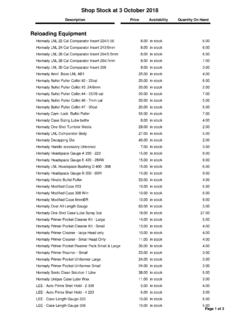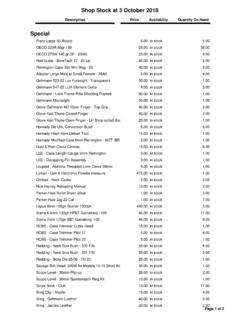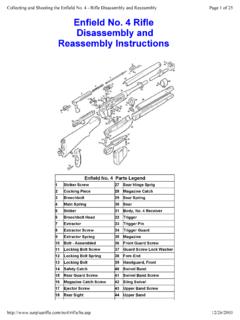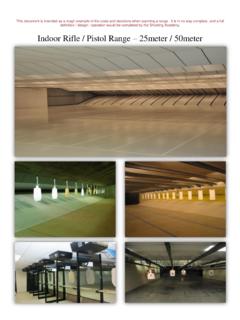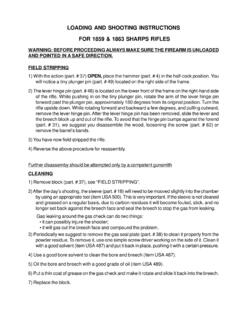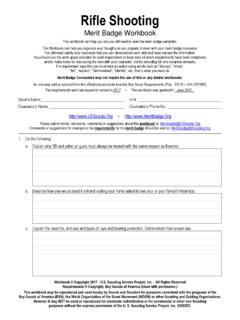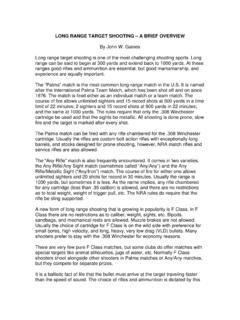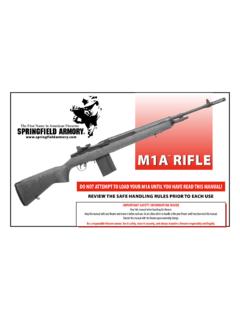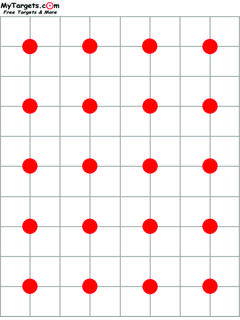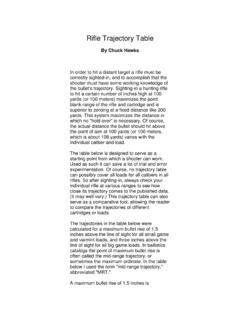Transcription of F Class Target Shooting Techniques Level 1 Forward
1 F Class Target Shooting Techniques Level 1 Forward This course comprises: - Course Instruction contents (1 page) - Course Instruction (20 pages) - Shot Diagnostic Chart (1 Page) - Learning Outcomes (2 pages) - Assessment (8 pages) This Course was originally designed to be delivered by a Certificate iv or higher Trainer and Assessor, comprising 1 full day, with the Training delivery taking the morning and the Assessment taking the afternoon. The Course was envisaged to be an in house course for the Rosedale Rifle Range and its F Class shooters, however after some persuasion the course is being made available electronically.
2 This is a far better outcome to benefit all F Class shooters, not just those based at the Rosedale Range and I endorse this increased exposure. Please appreciate the difficulty in presenting a worded document versus a document being delivered by a Trainer. Many misconceptions and interpretations can be corrected in a Training situation or in a one on one Assessment. Accept the document in the spirit in which it was written, and that is to increase the basic knowledge of all F Class shooters. If the reader takes away just one point from the Course that improves his/her I will have achieved what I set out to do.
3 This Course is the culmination of many months of fact finding research and many years of refining Shooting Techniques by many people. It is most certainly not all my work. Thank you to the many people who have contributed their experience and knowledge to this project. Rod Dolman President Rosedale Rifle Range F Class Target Shooting Techniques Level 1 course instruction Contents Page 1 Setting the rifle onto the front Page 2 Front rest-prone Page 3 Front rest-bench rest Page 4 Setting the rifle onto the rear sand Page 4 Geometry of the Shooting Page 5 Behind the Page 6 Head Page 6 Holding the Page 7 Cheek Page 7 Shoulder/butt position and Page 7 Trigger release/Pistol grip/Trigger Page 8 Page 9 Follow Page 10 Rifle Page 10 Focusing the Page 10 Page 11 Steps to reduce Page 12
4 Levelling the Page 12 Marrying the scope to the Page 13 Page 14 Page 14 Gyroscopic Page 15 Ballistic Page 16 Page 17 Minute of Page 17 Atmospherics and Page 18 F Class Target Shooting Techniques Level 1 course instruction This course is designed for prone and benchrest Target Shooting , to improve the shooters knowledge of: - Firearm Safety - Knowledge of F Class Shooting Techniques and Equipment - Marksmanship At the completion of this course you will be assessed for Level 1 F Class Target Shooting Techniques certification. 1. FIREARM SAFETY As you have your firearms licence, you will have passed the required safety test.
5 That test will not be repeated here and it will be assumed that the participant has the required safe attitude to own a rifle. There is one word I associate with firearm safety: - RESPECT Respect for yourself, your rifle and your fellow people around you. It is a privilege to own a rifle, not a right. Be aware of the minute details of your rifle. You must know at all times the exact state of your rifle, where it is, where the bolt is, when it was last cleaned, how many rounds fired since it was last cleaned, the elevation and wind settings for your last shoot. Know everything there is to know about your rifle and be fussy and precise.
6 Keep dirt and water out of the barrel. Keep the bedding dry and clean. Grease the bolt lugs. The moment you do not respect your rifle is the very moment it will not respect you. Safety is measured by actions! NEVER, FOR ANY REASON, POINT A RIFLE AT ANYONE TREAT EVERY RIFLE AT ALL TIMES AS THOUGH IT IS LOADED LEAVE BREECH OPEN WHEN NOT FIRING ALWAYS OBEY THE INSTRUCTIONS OF A RANGE OFFICER KEEP FINGERS AWAY FROM TRIGGER UNLESS AIMING AT THE Target IS NO ACCIDENT, IT IS YOUR RESPONSIBILITY! We enjoy a sport where there is no room for error. Safety is paramount in everything we do.
7 Whilst at the Range, the Range Officer is the all knowing, merciless God of your universe. Safety procedures are there for a reason and they are not flexible. You must have a working knowledge of these safety procedures or your stay at the Range will be exceptionally short. These safety procedures are outlined in the RANGE MEMBERS HANDBOOK. READ IT! Whilst at the Range the chain of command is: Range In the event of a misfire you MUST advise the SCORER, who will advise the RANGE OFFICER. The SHOOTER will not start Shooting until the SCORER has CLEARLY signalled to at your scorer to get the signal to commence.
8 The SCORER is at all times under the direct control of the RANGE OFFICER. Page 2 2. SETTING THE RIFLE ONTO THE FRONT REST/BI-POD Rifle with back bag and F Class bipod Bi-pod: There are 2 types of bi-pods. The Harris and Atlas type is a lightweight, flip down, swivel bi-pod with 2 adjustable legs. It attaches to the stock fore-end by lug attachment or bi-pod indented rail. When using this type of bi-pod, load the bi-pod up by Forward and downward pressure. This will require a little shoulder pressure at the butt and a firm trigger hand grip.
9 Harris Bipod F Class Bipod The position of your left hand (for right-handed vice-versa for left-handed shooters) is variable, depending on the calibre and your comfort position. For heavy recoil rifles many shooters prefer to hold the rifle stock with the left hand as an additional brace. This can interfere with accuracy unless your hold is controlled and precise. Refer to Section 4 for additional information. The preferred method is left elbow on the ground with the left fore-arm tucked across the chest lightly touching the rear bag or right elbow.
10 This method forms a rigid skeletal 3 point brace, with the rifle forming an extension of the skeletal structure. Page 3 Heavy recoil will cause a variety of additional control problems. If you have heavy recoil, consider a lighter projectile, limb-saver butt pad, recoil reducers, muzzle- break (where permitted) or even a smaller calibre. Target Shooting is all about accuracy and little about the weight of the projectile or how fast it is about this subject in the ballistics section, but suffice to say at this point that bigger and faster is not always better. The second type of bi-pod is the aluminium braced F- Class bi-pod that attaches to the stock fore-end by indented rail.
